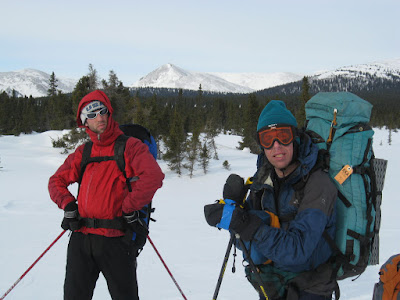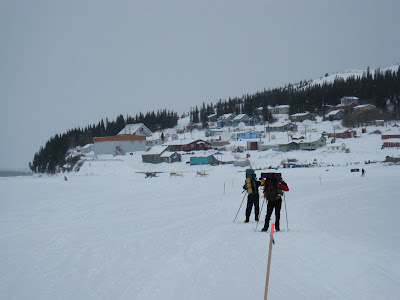 Wrangell-St Elias National Park is the site of the 2008 Alaska Mountain Wilderness Ski Classic. Brian and I are headed down to this pristine wilderness which straddles the Alaska-Yukon border tomorrow to take part in the race. This is a remote and dynamic region made up of 16,000 ft glaciated mountains, craggy peaks, volcanoes, winter avalanches, raging rivers in the summer, and an abundance of wildlife.
Wrangell-St Elias National Park is the site of the 2008 Alaska Mountain Wilderness Ski Classic. Brian and I are headed down to this pristine wilderness which straddles the Alaska-Yukon border tomorrow to take part in the race. This is a remote and dynamic region made up of 16,000 ft glaciated mountains, craggy peaks, volcanoes, winter avalanches, raging rivers in the summer, and an abundance of wildlife.
Friday, March 21, 2008
Gearing up for the Wilderness Classic
Posted by
Ed Plumb
at
11:11 PM
2
comments
![]()
Sunday, March 16, 2008
Skiing the Iditarod Trail

Four of us spent 6 days traversing the last 200 miles or so of the Iditarod trail along the wind scoured Bering Sea coast between the village of Koyuk and the bustling bush town of Nome. This was an unbelievably diverse trip which was jam packed with broad expanses of wilderness, cultural interactions as we passed through native villages, and the excitement of the Iditarod sled dog race as we skied in the midst of the mushers making their final push into Nome.










































Posted by
Ed Plumb
at
10:35 PM
2
comments
![]()
Labels: Ski Traverse
Thursday, March 6, 2008
Nome-ward Bound...
 I am headed out to the Seward Peninsula in western Alaska tomorrow with my skis and some friends. The Seward Peninsula is a thumb of the state that points directly at Siberia. All that separates Alaska from far east Russia is the icy Bering Strait.
I am headed out to the Seward Peninsula in western Alaska tomorrow with my skis and some friends. The Seward Peninsula is a thumb of the state that points directly at Siberia. All that separates Alaska from far east Russia is the icy Bering Strait.
I spent the evening packing a bunch of food and snacks for 5 or 6 days on the trail. We will be passing through several native villages so we will have the opportunity to buy food along the way - for an outrageous price of course. This should be an awesome trip through some interesting country. I will post some pics when I return...
Posted by
Ed Plumb
at
11:15 PM
5
comments
![]()
Sunday, March 2, 2008
Kite skiing

Industrious young Dan decided he wanted to build a kite for skiing. So he found a design online, ordered the materials, bought a sewing machine, taught himself how to use the darn thing - and voila! he made a kite! Since there was a little bit of wind today - Dan, Ted and I headed down to the Tanana River to get some practice flying the kite. After a few attempts I began to get the feel for how to control the big green wing. We were able to zig-zag down the river using a method similar to tacking a sailboat into the wind.


 Well...kite skiing isn't as easy as it appears.
Well...kite skiing isn't as easy as it appears.Check out this video of the kite in action
Posted by
Ed Plumb
at
9:58 PM
3
comments
![]()
Labels: Kite Skiing

